Contents
- 1. User manual 1
- 2. User manual 2
User manual 2
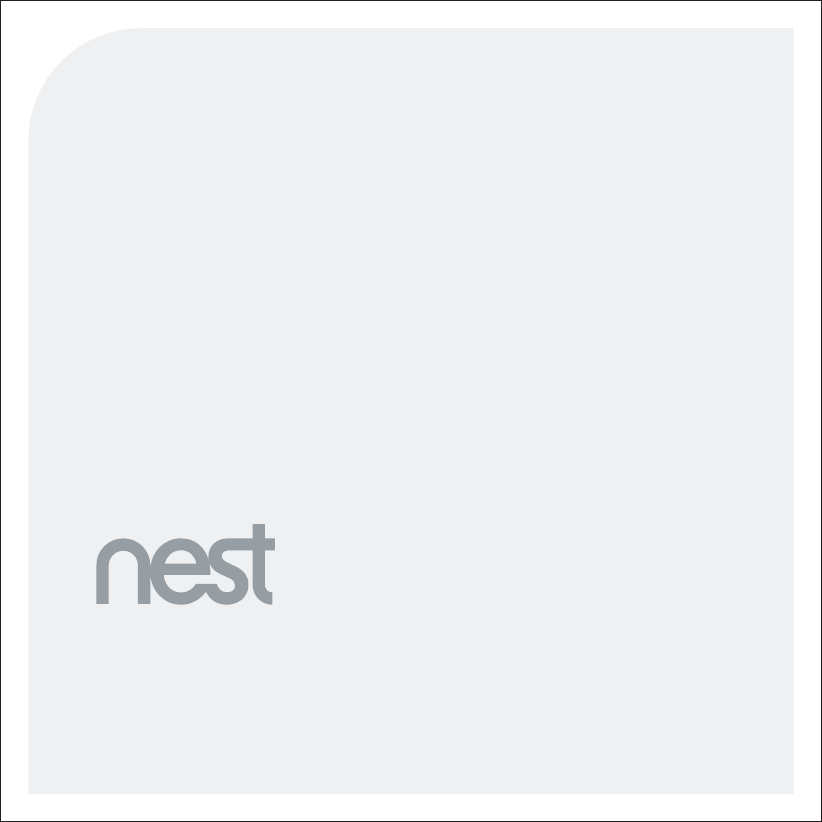
Nest Protect™(Wired 120V ~ 60Hz)
Detects smoke and carbon monoxide (CO)
User’s Guide
ATTENTION: Please read carefully and keep this user’s guide in a safe place.

32
TABLE OF CONTENTS
Meet your Nest Protect . . . . . . . . . . . . . . . . . . . . . . . . . . . . . . . . . . . . . . . . . . . . . . . . . . . . . . . . . . . . . . . . . . . . . . . . . . . . . . . . . . . . . . . . . . . . . . . . . 4
Setup and installation . . . . . . . . . . . . . . . . . . . . . . . . . . . . . . . . . . . . . . . . . . . . . . . . . . . . . . . . . . . . . . . . . . . . . . . . . . . . . . . . . . . . . . . . . . . . . . . . . . 6
Location in your home . . . . . . . . . . . . . . . . . . . . . . . . . . . . . . . . . . . . . . . . . . . . . . . . . . . . . . . . . . . . . . . . . . . . . . . . . . . . . . . . . . . . . . . . . . . . . . . . . . . 8
Placement on the ceiling or wall . . . . . . . . . . . . . . . . . . . . . . . . . . . . . . . . . . . . . . . . . . . . . . . . . . . . . . . . . . . . . . . . . . . . . . . . . . . . . . . . . . . . . 10
Heads-Up and Emergency Alarms . . . . . . . . . . . . . . . . . . . . . . . . . . . . . . . . . . . . . . . . . . . . . . . . . . . . . . . . . . . . . . . . . . . . . . . . . . . . . . . . . .16
Daily Use and Emergency Preparation . . . . . . . . . . . . . . . . . . . . . . . . . . . . . . . . . . . . . . . . . . . . . . . . . . . . . . . . . . . . . . . . . . . . . . . . . . . . .18
General Maintenance . . . . . . . . . . . . . . . . . . . . . . . . . . . . . . . . . . . . . . . . . . . . . . . . . . . . . . . . . . . . . . . . . . . . . . . . . . . . . . . . . . . . . . . . . . . . . . . . . .20
Safety . . . . . . . . . . . . . . . . . . . . . . . . . . . . . . . . . . . . . . . . . . . . . . . . . . . . . . . . . . . . . . . . . . . . . . . . . . . . . . . . . . . . . . . . . . . . . . . . . . . . . . . . . . . . . . . . . . . . . . 24
Limited Warranty . . . . . . . . . . . . . . . . . . . . . . . . . . . . . . . . . . . . . . . . . . . . . . . . . . . . . . . . . . . . . . . . . . . . . . . . . . . . . . . . . . . . . . . . . . . . . . . . . . . . . . . . 34
First, a word about privacy.
We’re committed to being open and honest about how
we use data. We will always ask for permission before
sharing personally identifiable information like your
email address, and we keep your data safe with the
same security tools banks use. Go to nest.com/privacy
to learn more about our Privacy Policy. Want to see how it’s done? Go to nest.com/installprotect for installation videos and tips.
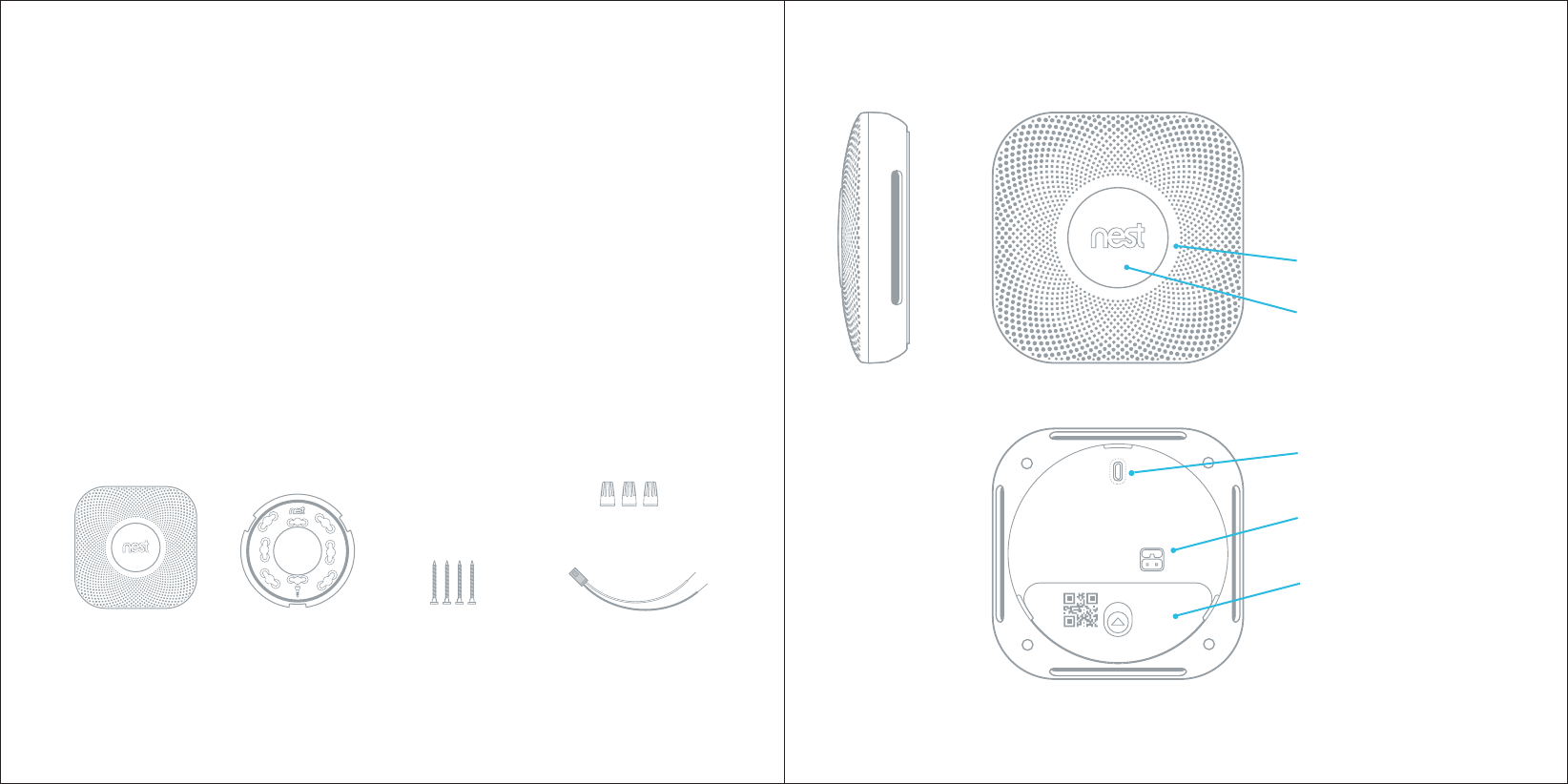
4 mounting screws
Nest Protect Backplate 120V connector
3 wire nuts
5.3 in
(13.5 cm)
1.5 in
(3.9 cm)
54
MEET YOUR NEST PROTECT
REQUIREMENTS
You need Wi-Fi, an iOS or Android phone or
tablet, and a free Nest Account in order to
use some Nest Protect features: spoken room
names, wireless mobile notifications, and
software updates. During setup, Wi-Fi and
a free Nest Account are required for wireless
interconnect and room naming. After all the
Nest Protects in your home are connected,
they can communicate with each other
without Wi-Fi.
The horn enables
Nest Protect to alert
you with a loud
emergency sound.
The speaker allows
Nest Protect to speak
with a human voice.
The light ring changes
color to alert you.
Push the Nest button to
hush alarms or run a test.
Micro-USB connector
(not for normal use).
AC connector pins for
the 120V connector.
Backup battery
compartment: Three
AA Energizer® Ultimate
Lithium batteries (L91).
Nest Protect is designed to detect smoke and
carbon monoxide in a residential environment.
It has multiple sensors to help it understand
what’s happening in your home, including
a Split-Spectrum Sensor to detect a wide range
of slow-smoldering and fast-flaming fires.
This guide covers the installation of Nest Protect
(Wired) - Model number 06C.
Inside the box you’ll find:
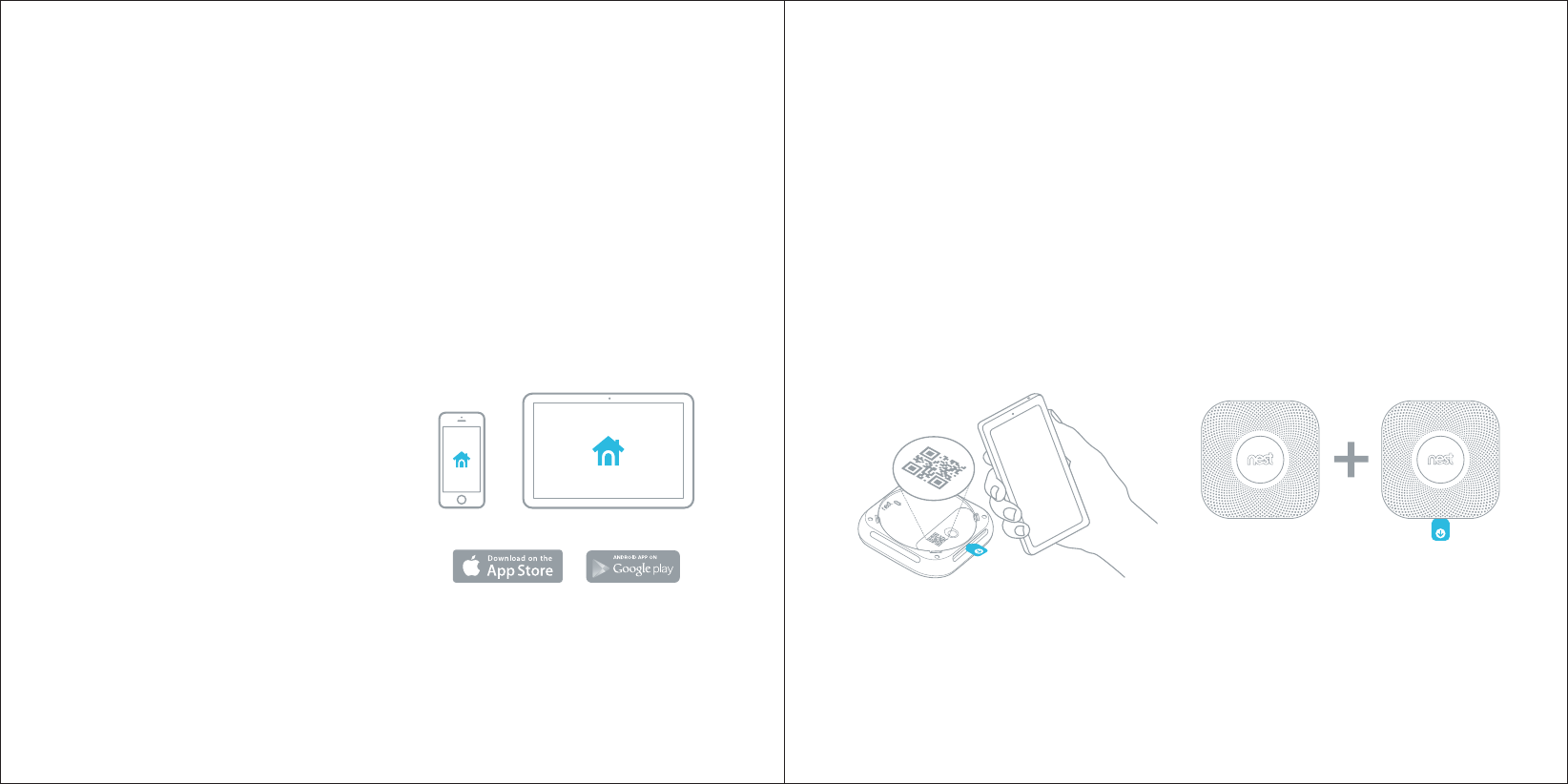
Already added New
76
1. Get the Nest app
Before you install your Nest Protect on the
ceiling or wall, you’ll need to set it up with
the Nest app. Download the app from the
Apple App Store™ or Google Play™ and create
a free Nest Account. You can use a phone or
tablet for setup.
SETUP AND INSTALLATION
(Professional installation recommended)
3. Have more Nest Protects?
The Nest app will ask you if you have additional
Nest Protects to set up. If so, it’ll take you
through a faster setup. Be sure to keep all your
Nest Protects together until they’re all set up
and ready to be installed.
2. Set up Nest Protect
The Nest app will guide you through each
step: scanning the Nest Protect QR code,
connecting it to the Internet, and connecting
it to other Nest Protects in your home. Go to
nest.com/installprotect to watch the video.
The installation of a smoke and CO alarm
should be made by a qualified technician,
and all wiring used to install this alarm
should be made in accordance with articles
210, and 300.3B of the National Electrical
Code ANSI/ NFPA 70, NFPA 72, and/or
applicable codes in your local jurisdiction.
For additional installation instructions and
safety warnings, refer to page 24.
Tip: Your Nest Protect came packed in a plastic cover.
Keep the cover on so your Nest Protect stays clean
until you install it.
Tip: Lay everything out on a table for easy setup.
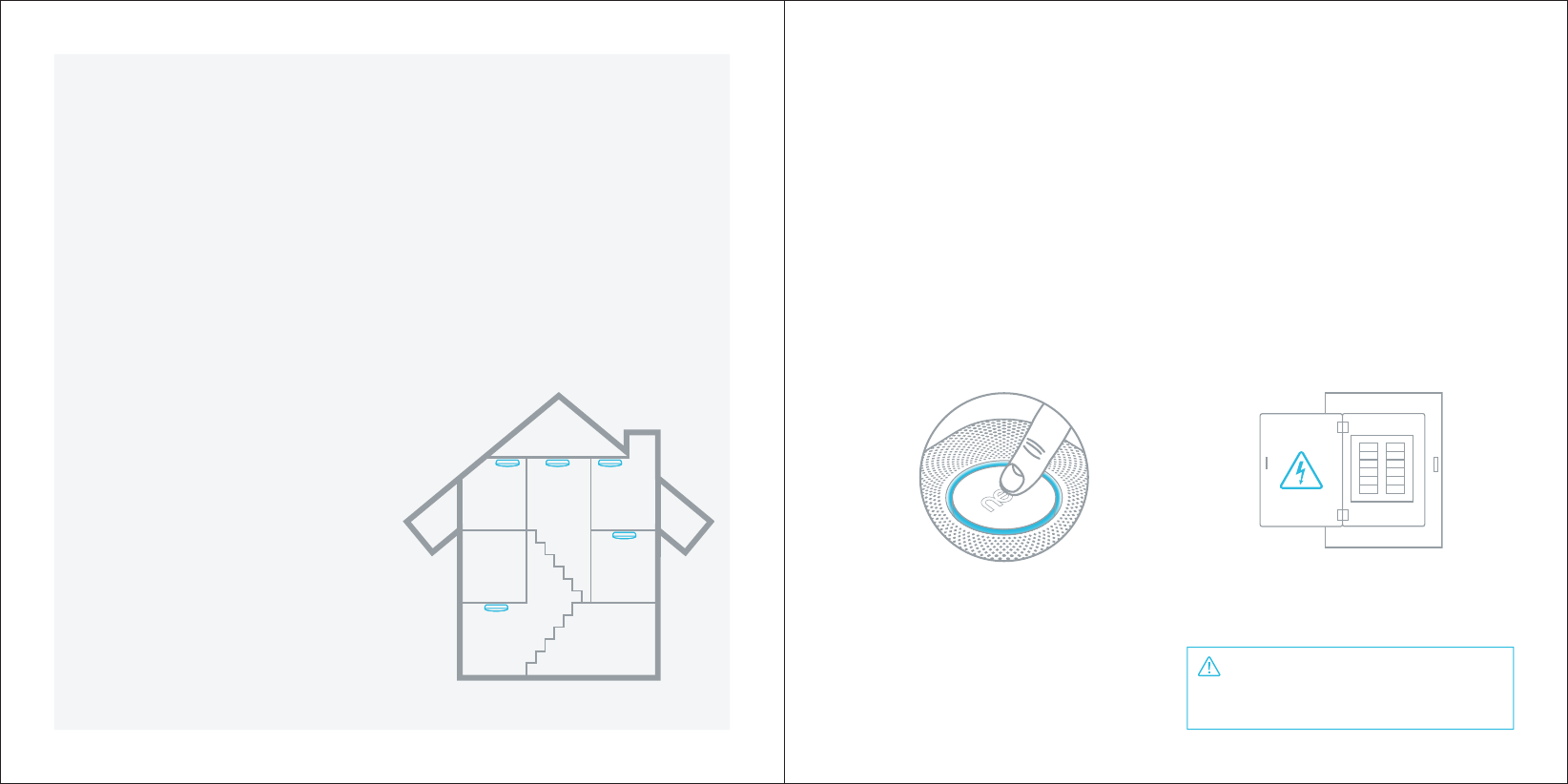
Breaker box
BEDROOM MASTER
BEDROOM
LIVING/
FAMILY
ROOM
KITCHEN
GARAGEBASEMENT
HALL
ATTIC
98
5. Turn off power
Protect yourself and avoid blowing a fuse.
Switch off the correct circuit breaker for the
room where you are installing Nest Protect
or remove the fuse from the fuse box.
WARNING
ELECTRICAL SHOCK HAZARD
Failure to turn off the power may result in
serious electrical shock, injury and death.
Tip: To double check Nest Protect’s room name,
press the Nest button once. You’ll hear the location
you assigned it during setup. It’ll say something like,
“Ready in the bedroom.”
Location in your home
The National Fire Protection Association
(NFPA) recommends installing a smoke alarm
in the following areas:
• On every floor, including finished attics
and basements.
• Inside and outside every sleeping area.
• At the top of the first-to-second floor
stairway and on the basement ceiling near
the entry of the stairs.
• In homes with more than 1,000 square feet
(93 m2) on one level, additional alarms may
be required.
Nest Protect should be installed at
least 10 feet (3 m) away from cooktops
or cooking appliances.
Nest Protect should NOT be installed
in unfinished attics or garages.
4. Test before you install
Once you’re done setting up all of your Nest
Protects, make sure they’ve been added to
your Nest Account. Push the Nest button on
one Nest Protect and follow the instructions.
All of your Nest Protects should speak up.
Now you can install them on the ceiling or wall.
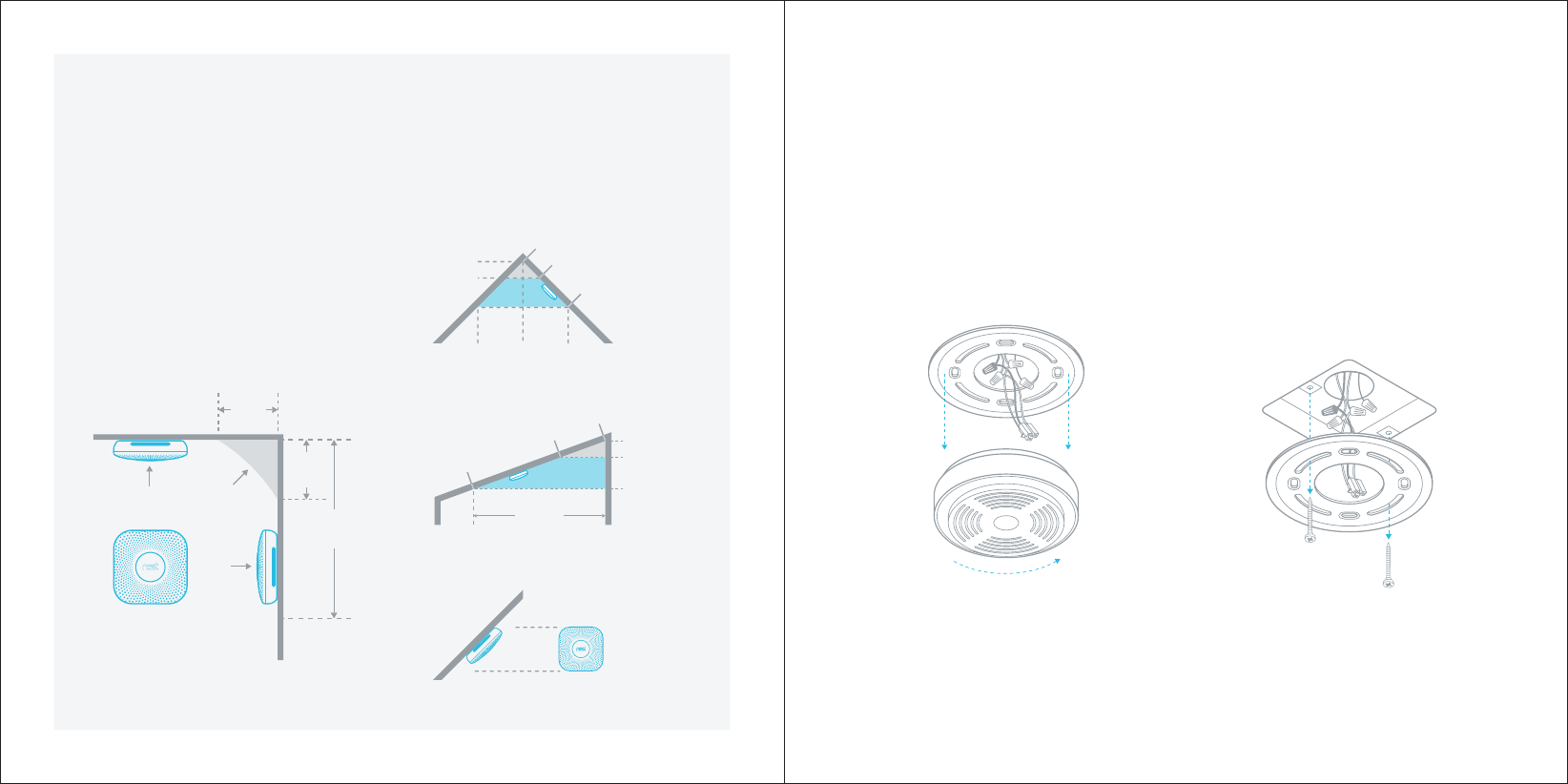
12 in
(30.5 cm)
Maximum
BEST
HERE
4 in
(10 cm)
Minimum
4 in
(10 cm)
Minimum
NOT IN
THIS AREA
CEILING
SIDE
WALL
OKAY
HERE
NEST LOGO
IS UPRIGHT
NOT IN
THIS AREA
ANYWHERE IN
THIS AREA
NOT IN
THIS AREA
ANYWHERE IN
THIS AREA
NEST LOGO
IS UPRIGHT
4 in
(10cm)
4 in
(10cm)
3 ft
(0.9 m) 3 ft
(0.9 m)
3 ft
(0.9 m)
Figure 1
Figure 2
Figure 3
Figure 4
1
22
1110
7. Remove the old backplate
Unscrew the backplate from the electrical
box. Save the screws to install the Nest
backplate later.
6. Remove your old smoke alarm
To prevent electrical shock, make sure the
green power light is off on the alarm. You
may have to twist the alarm to release it.
Carefully remove it to keep from damaging
your ceiling or wall.
Placement on the ceiling or wall
Installing on the ceiling is recommended.
Mark where the screws will go using the
base as a guide. Make sure it’s at least
4 inches (10 cm) away from the wall.
Placement on a sloped ceiling
If you have a sloped, peaked or cathedral
ceiling, Nest Protect should be 4 inches to
3 feet (10 cm – 1 m) from the highest point.
Tip: Your old smoke alarm might make a loud noise
when you disconnect it.
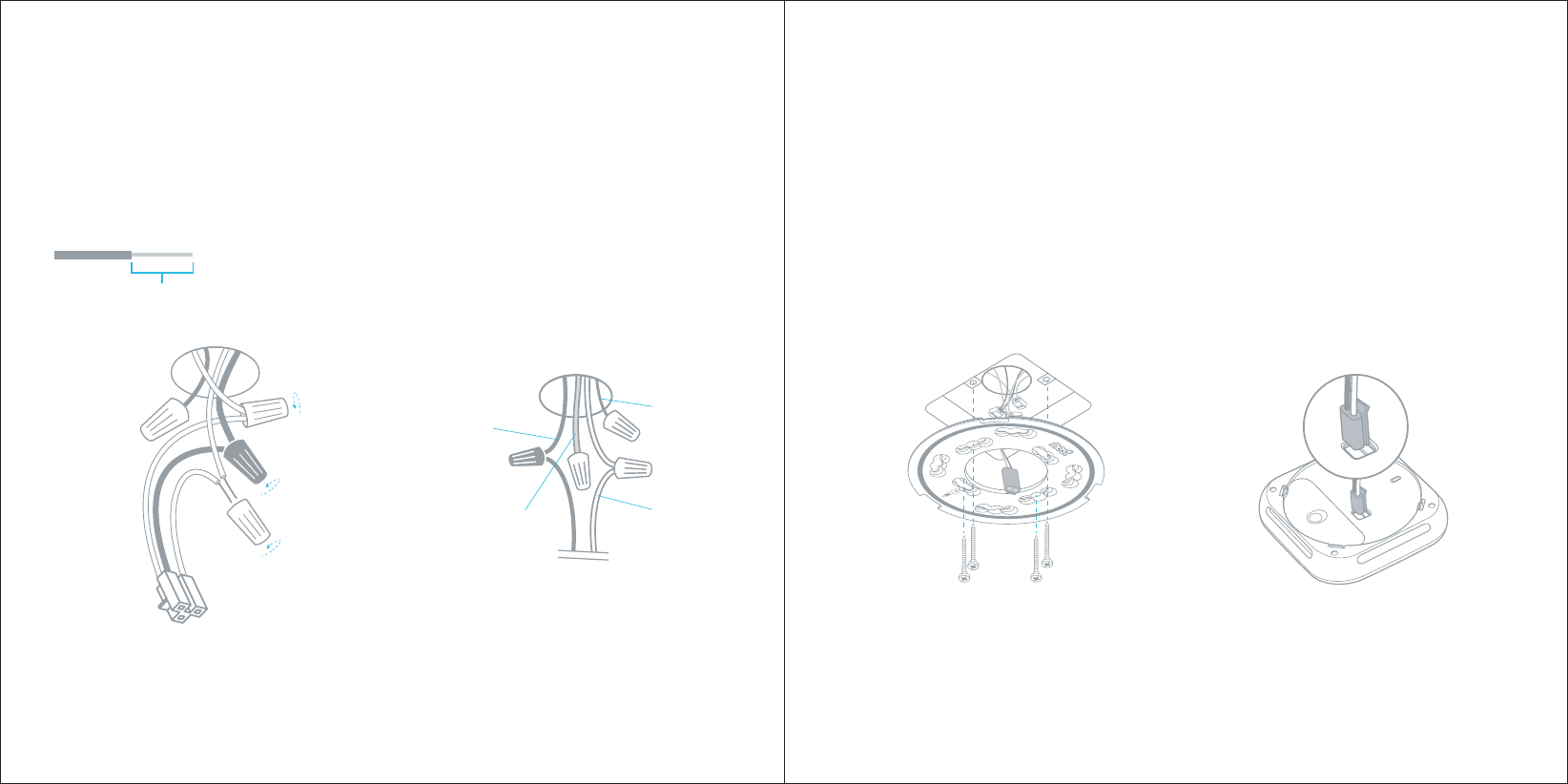
White:
Neutral line
Black:
Power line
Bare copper
Red/orange/yellow:
Interconnect
3/8 in (1 cm)
The exposed wire should be straight.
1312
Tip: All smoke alarms prefer to live in a dust free area,
so remove any dust before you install Nest Protect.
9. Attach the Nest connector
Hold the white wire ends together, cap them
with a wire nut and twist clockwise until it’s
secure. Do the same with the black wires.
There’s no need for the red/orange/yellow
wire. Simply cap it with a wire nut and twist
until secure.
8. Remove the old connector
Unscrew the wire nuts to detach the 120V
connector from your old smoke alarm.
10. Install the Nest backplate
Screw the Nest backplate to the existing
electrical box, reusing the existing screws.
You can also screw the backplate directly
into the wall or ceiling with the Nest screws.
11. Connect power
Plug the 120V connector into the back of
your Nest Protect.
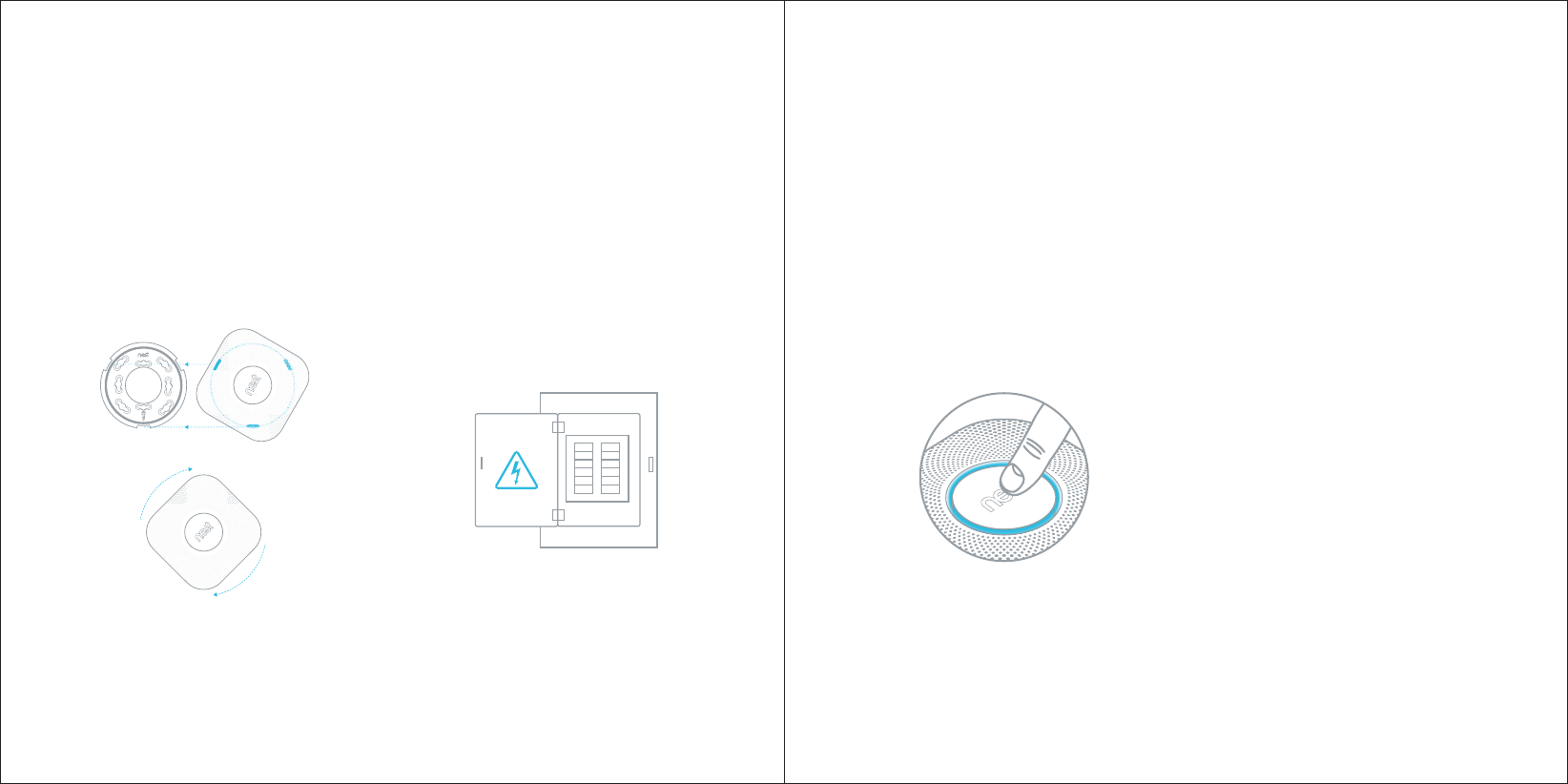
Breaker box
1
1
2
2
1514
12. Install your Nest Protect
First, tuck any excess wiring into the electrical
box. Line up the three tabs on the back of your
Nest Protect with the notches on the backplate.
Hold Nest Protect against the backplate and
turn it clockwise. Continue turning until it’s
square with the wall or ceiling. Install the rest
of your Nest Protects if you have more.
13. Switch power back on or replace
the fuse 14. Press to test
Press the Nest button on one Nest Protect.
It will tell you what to do next. Every
Nest Protect in the house should speak
up, confirming that they’re connected to
each other.
Tip: If you ever need to remove it (for cleaning or
battery replacement), turn off power to your
Nest Protect at the breaker box or remove the
fuse first. Then turn counterclockwise until it
disconnects from the backplate.

WHAT YOU HEAR
ALERTSSILENCING
WHAT IT MEANS WHAT TO DO
“HEADS-UP. THERE’S
SMOKE IN THE [ROOM
NAME]. THE ALARM
MAY SOUND.”
Smoke levels are rising. Put out the source of the
smoke. Then use the Nest
app or press the Nest
button to hush the alert.
Open a window or door
to get fresh air. Then use
the Nest app or press
the Nest button to hush
the alert.
Get out of the house
immediately.
Make sure you’re safe and
have put out the source of
smoke or carbon monoxide.
1) Operate reset/silence
button (Nest button).
2) Call your fire dept. or 911.
3) Move to fresh air.
4) Do not reenter the
premises until the
emergency services tell
you to. Refer to page 30
for complete instructions.
Carbon monoxide
levels have been high
for a while.
You’ve hushed an alert.
Nest Protect will now
keep quiet, unless smoke
or carbon monoxide
remains at critical levels.
The carbon monoxide in
the room has reached
critical levels.
“HEADS-UP. THERE’S
CARBON MONOXIDE IN
THE [ROOM NAME]. THE
ALARM MAY SOUND.”
(Alarm sound)
“EMERGENCY. THERE’S
CARBON MONOXIDE IN
[ROOM NAME]. MOVE TO
FRESH AIR.”
(Alarm sound)
“EMERGENCY. THERE’S
SMOKE IN [ROOM NAME]”
“SMOKE ALARM HUSHED.”
“CARBON MONOXIDE
ALARM HUSHED.”
“THE ALARM IS OVER.”
YELLOW pulses.
YELLOW pulses.
RED pulses.
RED pulses.
YELLOW or
RED pulses.
GREEN pulses.
WHAT YOU SEE
HEADSUP AND EMERGENCY ALARMS
The smoke in the
room has reached
critical levels.
Make sure you’re safe and
have put out the source or
smoke or carbon monoxide.
Smoke or carbon
monoxide levels
are decreasing.
1716
HEADSUP AND EMERGENCY ALARMS
ALERTS
When Nest Protect has something to say, it
will speak to you in words and light up instead
of just beeping. Nest Protect has two kinds of
voice alerts: Heads-Up and Emergency Alarms.
When smoke or carbon monoxide levels are
heightened but haven’t yet reached Emergency
Alarm levels, Nest Protect can sound a Heads-Up
as an early warning. Nest Protect will pulse
yellow and tell you where there’s smoke or
carbon monoxide.
You’ll get an Emergency Alarm when smoke or
carbon monoxide reach critical levels. Nest
Protect will pulse red, sound a loud alarm, and
tell you what room the emergency is in. If there’s
both smoke and CO present, the smoke alarm
will take priority.
SILENCING
Heads-Up alerts and some Emergency Alarms
can be hushed by using the Nest app or
pressing the Nest button. In some cases, the
smoke level may be too high for the Emergency
Alarm to be hushed. Only silence an alarm
once you have checked conditions at the Nest
Protect that first sounded the alarm. Do not
silence Nest Protect by disconnecting it from
line voltage and removing the batteries. This
will disable the alarm so it cannot sense smoke
or carbon monoxide, leaving you at risk.
Because there are many different types of fires,
you may experience an Emergency Alarm without
having first experienced a Heads-Up alert.
This means that critical levels of smoke or CO
occurred extremely quickly and Nest Protect
has to sound the Emergency Alarm.
HAVE MORE THAN ONE NEST PROTECT?
After all the Nest Protects in your home are
connected to each other, if there’s a Heads-Up
or an Emergency Alarm in one room, they’ll all
tell you what the danger is and which room it’s in.
If multiple Nest Protects are interconnected,
a Heads-Up alert or Emergency Alarm can be
silenced only at the Nest Protect that originally
sounded the alert. You’ll need to go to that room
to hush all the Nest Protects in your home.
Always check the conditions near the Nest
Protect that first detected the smoke or carbon
monoxide before silencing it.

DAILY USEEMERGENCY
PREPARATION
GREEN light above
the Nest logo.
You turn off the
room lights for
the night, and
the GREEN light
pulses once.
WHITE light.
BLUE rotates.
Sleep well thanks to
Nightly Promise.
Press the Nest button.
Nest Protect will walk
you through next steps.
Nest Protect is working.
The green light means
AC power is connected.
Nest Protect has tested
its sensors and batteries
to confirm they are
working correctly.
Pathlight lights your way at
night as you pass under it.
It can also be set to stay on.
To set up or run
a manual test.
“READY. PRESS TO TEST.”
WHAT YOU HEAR WHAT IT MEANS WHAT TO DOWHAT YOU SEE
DAILY USE AND EMERGENCY PREPARATION
WARNING
• DO NOT stand close to the alarm when
the horn is sounding. Exposure at close
range may be harmful to your hearing.
When testing, step away before the
horn starts sounding.
• If the alarm ever fails to test correctly,
have it replaced immediately! If the alarm
is not working properly, it cannot alert you
to a problem.
• DO NOT use a match, cigarette or any other
makeshift fire to test the smoke alarm.
• To test the CO alarm, NEVER use vehicle
exhaust! Exhaust may cause permanent
damage and will void your warranty.
• NEVER use an open flame of any kind
to test this alarm. You might accidentally
damage or set fire to the unit or to
your home.
1918
DAILY USE
POWER
Nest Protect (Wired 120V) has a small green light
located at the top of the Nest button. It will be on
as long as Nest Protect is getting AC power from
the electrical wires.
If there’s a wiring problem or power outage, the
green light will turn off and Nest Protect will
switch to backup batteries. You’ll also see a
yellow (instead of green) Nightly Promise light
when you turn off the lights for the night.
NIGHTLY PROMISE
Nest Protect continuously tests itself, so
you don’t have to wonder if it’s working.
Nightly Promise reports on every Nest Protect
in your home.
When you turn out the lights for the night,
Nest Protect will glow green for a moment - that
means everything is working. If it glows yellow,
one of the Nest Protects in your home needs
your attention. For instance, the batteries are
low, Wi-Fi is down, or there’s an issue with the
sensors. Just push the Nest button or use the
Nest app to see what’s wrong.
PATHLIGHT
Usually Nest Protect has its light turned off, but
it can light your way as you walk underneath it
in the dark. You can enable or disable Pathlight
and set its brightness with the Nest app. Nest
Protect (Wired 120V) also allows you to set
Pathlight to “Always On” if you want a night light.
It will turn on when it’s dark and stay on until it’s
light again.
DAILY USE AND EMERGENCY PREPARATION
EMERGENCY PREPARATION
TESTING
Perform a manual test of your wired Nest
Protect at least monthly. During a test, all
interconnected Nest Protects in your home
check their sensors, power, Wi-Fi connection,
emergency horn, speaker and microphone.
When you run a test, Nest Protect will give you
a countdown before sounding the alarm so you
have time to move away from the loud noise.
Test procedure:
1. Start a test by pressing the Nest button twice.
2. Nest Protect will say: “This is only a test.
The alarm will sound.”
3. Ensure that the alarm sounds and the light
illuminates on each Nest Protect.
4. Once the Nest Protect has made sure it’s
working, it’ll tell you everything’s okay. If you
have interconnected Nest Protects, all of
them should speak.

2120
3
2
1
3
2
1
2. Twist Nest Protect counterclockwise until
it disconnects from the backplate.
3. Detach the power connector
from the back of Nest Protect
and open the battery door.
4. Replace the batteries.
Align the + positive and
- negative ends with the
markings in the battery
compartment.
5. Close the battery compartment.
Do not force the door closed.
6. Reattach the power connector.
7. Push Nest Protect onto the backplate and
turn it clockwise until you feel it grip.
8. Turn power to Nest Protect back on at the
breaker box.
9. Press the Nest button twice.
SERVICING
1. Before sending Nest Protect for service,
visit nest.com/support
2. If your Nest Protect needs servicing,
first contact our support team to get
a return number
3. Send your Nest Protect to:
Nest Labs
(YOUR RETURN NUMBER)
4 East Stow Road
Marlton, NJ 08053 USA
GENERAL MAINTENANCE
CLEANING YOUR NEST PROTECT
Nest Protect has been designed to be as
maintenance free as possible, but you should
keep it clean. As with any smoke alarm,
dust buildup on the outside or inside of Nest
Protect can stop it from working properly.
To clean Nest Protect:
1. Turn off power to Nest Protect at the
breaker box (see p.9)
2. Remove it from the wall or the ceiling (turn
counterclockwise until it comes off the
backplate and detach the power connector).
3. Wipe the outside with a clean, slightly
damp cloth. Don’t use any soaps or solvents.
4. Place Nest Protect on a soft, dry cloth with
the Nest button facing down. Open the
battery compartment door and remove the
batteries. Remove the screws and lift off
the back. Be careful to not lose the screws.
5. Gently vacuum the inside. Make sure
to clean all the way around the mesh
sides of the smoke chamber (the large
metal circle).
Note: Never use detergents or solvents (like
glass cleaner) on your Nest Protect and do
not spray air fresheners, hair spray or other
aerosols near it. Do not get water inside the
alarm or paint over it.
REPLACING THE BACKUP BATTERIES
In case of a power outage, Nest Protect will
use three AA Energizer® Ultimate Lithium
batteries (L91) for backup. These batteries
can be purchased at your local retailer.
1. Turn off power to Nest Protect at the
breaker box (see p.9)
WARNING
• Use only batteries specified by Nest.
Use of a different battery model will
have a detrimental effect on the smoke
alarm operation.
• Never disconnect a wired alarm to stop
an unwanted alarm (caused by cooking
smoke, etc.) Removing power disables the
alarm so it cannot sense smoke or carbon
monoxide (CO). Instead open a window or
fan the smoke away from the unit.
• The batteries cannot work until you install
the batteries in the correct position
(Match + to + and - to -).
• Once Nest Protect has expired you’ll no
longer be protected from smoke or CO if
you don’t replace it.
GENERAL MAINTENANCE
YELLOW pulses. Low battery. Change the batteries
of Nest Protect now.
“THE BATTERY IS LOW IN
THE [ROOM NAME].
REPLACE THE BATTERY
NOW.” Single chirp
every 60 seconds.
Nest Protect has tested
its sensors and there is
a problem.
Clean according to
instructions on page 20.
If the problem persists,
replace Nest Protect.
“THE SENSORS HAVE
FAILED IN THE [ROOM
NAME]. REPLACE NEST
PROTECT NOW.” Single
chirp every 60 seconds.
Nest Protect has expired
and reached the end of
its life.
Replace Nest Protect now.
“NEST PROTECT HAS
EXPIRED. REPLACE IT
NOW.” Two chirps every
60 seconds.
There’s a problem with
the horn of Nest Protect. Replace Nest Protect now.
“NEST PROTECT CAN’T
SOUND THE ALARM IN
THE [ROOM NAME].”Two
chirps every 60 seconds.
YELLOW pulses. Change the batteries
of Nest Protect soon.
Low battery.
“THE BATTERY IS LOW IN
THE [ROOM NAME].
REPLACE THE BATTERY
SOON.”
YELLOW pulses.
YELLOW pulses.
WHAT YOU HEAR WHAT IT MEANS WHAT TO DOWHAT YOU SEE
GENERAL MAINTENANCE
YELLOW pulses.

2322
interference can be overcome by adding more
Nest Protects that can route wireless signals
around obstructions.
WIRELESS INTERCONNECT
Nest Protects connect wirelessly to each other
so that when one speaks, they all speak. That
means when one Nest Protect raises any kind
of alert, every Nest Protect in the house will
tell you which room the smoke or CO is in. For
example, if you’re in the bedroom and the alarm
goes off in the basement, the Nest Protect in
the bedroom will tell you where the smoke or
CO is. To silence the alert, go to the room where
the alarm was triggered. All of the Nest Protects
in the house can be hushed from there. Either
press the button on the Nest Protect or use use
the Nest app to hush the alarm.
Nest Protect - Wired 120V (model numbers 05C
and 06C) and Nest Protect - Battery (model
numbers 05A and 06A) and are compatible and
can be interconnected wirelessly. Nest Protect
wireless interconnect will not work with other
smoke or CO alarms from other brands.
Nest Protect’s 120V connector does not have
a red/orange/yellow wire for interconnect
because it connects wirelessly. There’s no need
to connect any Nest Protect wire to the red/
orange/yellow interconnect wire coming from
the ceiling or wall.
Nest Protects can typically communicate with
each other if they’re 50 feet (15 m) or less apart
inside a home. Some features of a home may
reduce Nest Protect’s wireless interconnect
range, including the number of floors, number
and size of rooms, furniture, type of building
materials, suspended ceilings, ductwork, large
metal appliances and metal studs. This kind of
GENERAL MAINTENANCE
EXPIRATION
Like any smoke and CO alarm, Nest Protect
has a limited life. You will need to replace
Nest Protect after 10 years with a brand new
Nest Protect. You can check the date
of replacement written on the back of
Nest Protect to see when it will expire.
About two weeks before it expires, Nest Protect
will light up with a yellow light. Press the
Nest button and it will say, “Nest Protect has
expired. Replace it now.” Buy a new alarm and
recycle the expired one. Make sure you test
your new Nest Protect once it’s installed.
RECYCLING AND DISPOSAL
Once Nest Protect has expired you will
need to recycle it according to local
regulations. Please visit nest.com/recycle
for more information.
RESETTING NEST PROTECT
You can reset Nest Protect to erase all your
settings and reset the wireless interconnection
with other Nest Protects. You may want to do
this when you move to a new home. Follow the
steps below on each Nest Protect you want
to reset.
1. Press and hold the Nest button. Nest will
chime and glow blue.
2. Keep holding the button until Nest Protect
begins to say its version number. Then
release the button.
3. Nest Protect will start a verbal countdown
and tell you it’s erasing all settings. You can
cancel the reset by pressing the Nest button
during the countdown.
4. After a few seconds it will restart.
Your Nest Protect will still detect smoke and
carbon monoxide after being reset.
Go to nest.com/protect/reset for complete
reset instructions.
WARNING
• The range and proper operation of any
wireless device will vary depending on
its surroundings.
• Nest Protect alarms are not to be used
outdoors or to transmit between buildings.
The alarms will not communicate properly
in those conditions.
• Metal objects and metallic wallpaper
may interfere with signals from wireless
alarms. Test your Nest Protects with metal
doors opened and closed.
Note: Nest Protect can be used as a single
station or multiple station alarm.

2524
ALARM LIMITATIONS
LIMITATIONS OF SMOKE ALARMS
Alarms reduce deaths resulting from home fires
worldwide. However smoke alarms can only
work if they are properly located, installed and
maintained, and if smoke reaches the alarms.
• Smoke alarms may not waken all individuals.
Make sure you create an escape plan and
you practice fire drills with all members of
the family.
• Smoke alarms cannot work without power.
If they are powered by batteries, the smoke
alarms cannot work if the batteries are
missing, dead or disconnected. If they are
wired, the smoke alarms cannot work during
a long power outage and once the backup
battery is dead. Nest Protect will warn you
in advance when batteries are running low
so that you can replace them.
• Smoke will not be able to reach smoke sensor
while the dust cover is in place. The dust cover
must be removed.
• Smoke alarms cannot detect fires if the smoke
does not reach the alarms. For example, if a
door is closed, smoke may not reach the smoke
alarm. This is why you should have a smoke
alarm in each bedroom and in the hallways as
bedroom doors may be closed at night.
• Smoke alarms may not be heard. Although
the smoke alarm comes with a loud horn of
85 decibels, it may not be heard if : 1) people
have consumed alcohol or drugs, 2) the
alarm is drowned by noise from stereo, TV,
traffic, air conditioner or other appliances,
3) residents are hearing impaired or have high
frequency hearing loss associated with aging.
Special smoke alarms should be installed for
those who are hearing impaired.
SAFETY
• This smoke alarm is not intended to
alert hearing impaired residents. Alarms
specifically designed for the hearing impaired,
which feature devices like flashing strobe
lights or low frequency devices are available to
alert the hearing impaired in case of fire.
• This smoke alarm alone is not a suitable
substitute for complete fire detection
systems in places housing many people—
like apartment buildings, condominiums,
hotels, motels, dormitories, hospitals,
long-term health care facilities, nursing
homes, day care facilities, or group homes
of any kind—even if they were once single-
family homes. It is not a suitable substitute
for complete fire detection systems in
warehouses, industrial facilities, commercial
buildings, and special-purpose non-
residential buildings which require special
fire detection and alarm systems. Depending
on the building codes in your area, this smoke
alarm may be used to provide additional
protection in these facilities.
LIMITATIONS OF CARBON MONOXIDE CO ALARMS
• NEVER ignore your carbon monoxide alarm if it
alarms. Refer to “What to do in case of a carbon
monoxide alarm” for more information. Failure
to do so can result in injury or death.
• This CO alarm is designed for use inside a
single-family home or apartment. It is not
meant to be used in common lobbies, hallways,
or basements of multi-family buildings unless
working CO alarms are also installed in each
family living unit. CO alarms in common areas
may not be heard from inside individual family
living units.
• This CO alarm alone is not a suitable substitute
for complete detection systems in places
which house many people, like hotels or
dormitories, unless a CO alarm is also placed
in each unit.
• DO NOT use this CO alarm in warehouses,
industrial or commercial buildings, special
purpose non-residential buildings, or airplanes.
This CO alarm is specifically designed for
residential use, and may not provide adequate
protection in non-residential applications.
• Some individuals are more sensitive to CO
than others, including people with cardiac or
respiratory problems, infants, unborn babies,
pregnant mothers, or elderly people can be
more quickly and severely affected by CO.
Members of sensitive populations should
consult their doctors for advice on taking
additional precautions.
• The silence feature is for your convenience
only and will not correct a CO problem. Always
check your home for a potential problem after
any alarm. Failure to do so can result in injury
or death.

2726
occupancy (small facility), including basements
and excluding crawl spaces and unfinished attics
(5) *In the living area(s) of a guest suite
(6) In the living area(s) of a residential board and
care occupancy”
(Reprinted with permission from NFPA 72®, National Fire Alarm
& Signaling Code Copyright © 2013 National Fire Protection
Association, Quincy, MA 02269. This reprinted material is
not the complete and official position of the National Fire
Protection Association, on the referenced subject which is
represented only by the standard in its entirety.) (National
Fire Alarm & Signaling Code® and NFPA 72® are registered
trademarks of the National Fire Protection Association, Inc.,
Quincy, MA 02269.)
SMOKE DETECTION
Are more smoke alarms desirable?
The required number of smoke alarms might
not provide reliable early warning protection
for those areas separated by a door from
the areas protected by the required smoke
alarms. For this reason, the use of additional
smoke alarms for those areas for increased
protection is recommended. The additional
areas include the dining room, and hallways
not protected by the required smoke alarms.
The installation of smoke alarms in kitchens,
attics (finished or unfinished), or garages is
not normally recommended, because these
locations occasionally experience conditions
that can result in improper operation. As Nest
Protect is also a Carbon Monoxide alarm, it is
not recommended to install it in a furnace room
or a utility room if it contains a water heater or
a furnace. It should be 15-20 feet from these
appliances to avoid transient conditions and/or
perceived nuisance alarms.
INSTALLATION CODE
THIS EQUIPMENT SHOULD BE INSTALLED IN
ACCORDANCE WITH THE NATIONAL FIRE
PROTECTION ASSOCIATION’S STANDARD 72
(National Fire Protection Association,
Batterymarch Park, Quincy, MA 02269).
Note: Specific requirements for Smoke Alarm
installation vary between countries, states, and
regions. Check with your local safety agency or Fire
Department for current requirements in your area.
WARNING
This product is intended for use in ordinary
indoor locations of family living units. It
is not designed to measure compliance
with Occupational Safety and Health
Administration (OSHA) commercial or
industrial standards.
WHERE TO INSTALL YOUR SMOKE ALARMS
For your information, the National Fire Alarm
and Signaling Code, NFPA 72, reads as follows:
“29.5.1 *Required Detection.”
“ *Where required by applicable laws, codes,
or standards for a specific type of occupancy,
approved single- and multiple-station smoke
alarms shall be installed as follows:
(1) *In all sleeping rooms and guest rooms
(2) *Outside of each separate dwelling unit
sleeping area, within 21 ft (6.4 m) of any door
to a sleeping room, the distance measured
along a path of travel
(3) On every level of a dwelling unit, including
basements
(4) On every level of a residential board and care
WHERE NOT TO INSTALL YOUR SMOKE ALARMS
For best performance, AVOID installing a smoke
alarm in these areas:
• Where combustion particles are produced.
Burning material creates combustion particles
which could cause your smoke alarm to go
off unnecessarily. Areas to avoid include
poorly ventilated kitchens, garages, boats,
recreational vehicles, and furnace rooms.
Keep a smoke alarm at least 20 feet (6 m)
from from the source of combustion particles
(stove, furnace, water heater, space heater)
if possible. In areas where a 20-foot (6 m)
distance is not possible – in mobile, or smaller
homes, for example – it is recommended
a smoke alarm to be placed as far from
these fuel-burning sources as possible. The
placement recommendations are intended
to keep a smoke detector at a reasonable
distance from a fuel-burning source, reducing
“unwanted” alarms. Unwanted alarms can
occur if a smoke alarm is placed directly next
to a fuel-burning source. Ventilate these areas
as much as possible.
• In air streams near kitchens. Air currents can
draw cooking smoke into the sensor of a smoke
alarm near the kitchen.
• In very damp, humid or steamy areas, or
directly near bathrooms with showers. Keep
a smoke alarm at least 10 feet (3 m) away from
showers, saunas, dishwashers, etc.
• Where temperatures are regularly below
40˚F (4˚C) or above 100˚ F (38˚C) including
unheated buildings, outdoor rooms, porches,
or unfinished attics or basements.
• In very dusty, dirty, or greasy areas. Do not
install a smoke alarm directly over the stove
or range. Clean a laundry room unit frequently
to keep it free of dust or lint.
• Near fresh air vents, ceiling fans, or in very
drafty areas. Drafts can blow smoke away from
a smoke alarm, preventing it from reaching
the sensor.
• In insect infested areas. Insects can clog openings
to the sensor and cause unwanted alarms.
• Less than 12 inches (30.5 cm) away from
fluorescent lights. Electrical “noise” can
interfere with the sensor.
• In “dead air” spaces. “Dead air” spaces may
prevent smoke from reaching a smoke alarm.
WHERE NOT TO INSTALL YOUR CO ALARMS
• Keep carbon monoxide alarm at least 10 ft (3 m)
away from any cooking appliance including
stovetop, oven, microwave, etc.
• This alarm should not be installed in locations
where the normal ambient temperature is
below 40°F (4.4°C) or exceeds 100°F (37.8°C).
EXAMPLES OF WHEN YOUR SMOKE ALARM
MAY NOT BE EFFECTIVE
Your alarm may not be effective in protecting
against fire in certain cases:
• Smoking in bed
• Leaving children unsupervised
• Cleaning with flammable liquids, like gasoline.
• When someone’s clothes have caught on fire
• Fires where the smoke is prevented from
reaching the alarm due to a closed door or
other obstruction
• Incendiary fires where the fire grows so
rapidly that an occupant can’t get out, even
with alarms in proper locations

2928
CARBON MONOXIDE CO PRECAUTIONS
WHAT IS CARBON MONOXIDE?
Carbon Monoxide (CO) is an invisible, odorless,
tasteless gas produced when fuels do not burn
completely, or are exposed to heat (usually fire).
These fuels include: wood, coal, charcoal, oil
natural gas, gasoline, kerosene, and propane.
Common appliances are often sources of
CO such as oil or gas burning furnaces, gas
ovens, wood-burning fireplaces, and charcoal
grills. If they are not properly maintained, are
improperly ventilated or malfunction, CO levels
can rise quickly. CO is a real danger now that
homes are more energy efficient. “Air-tight”
homes with added insulation, sealed windows,
and other weatherproofing can “trap” CO
inside. Electrical appliances typically do not
produce CO. The Nest Protect CO sensor meets
the alarm response time requirements of the
American National Standard ANSI/UL 2034.
Standard alarm times are as follows:
• At 70ppm, the unit must alarm within
60-240 minutes.
• At 150ppm, the unit must alarm within
10-50 minutes.
• At 40ppm, the unit must alarm within
4 to 15 minutes.
WARNING
This carbon monoxide alarm is designed
to detect carbon monoxide from any
source of combustion. It is NOT designed
to detect any other gas.
• The alarm cannot be operated from power
derived from a square wave, modified square
wave or modified sine wave, inverter. These
types of inverters are sometimes used to
supply power to the structure in off grid
installations, such as solar or wind derived
power sources. These power sources produce
high peak voltages that will damage the alarm
• Never disconnect the power from an
AC powered unit to stop an unwanted alarm.
Doing so will disable the unit and remove your
protection. In the case of a true unwanted alarm
open a window or fan the smoke away from the
unit. The alarm will reset automatically when it
returns to normal operation.
• Improper wiring of the power connector or
the wiring leading to the power connector
will cause damage to the alarm and may lead
to a non-functioning alarm. You must test to
ensure proper installation.
AC INSTALLATION WARNINGS
ELECTRICAL SHOCK HAZARD
• Turn off power to the area where you will
install this unit at the circuit breaker or fuse
box before beginning installation. Failure
to turn off the power before installation
may result in serious electrical shock, injury
or death.
• Do not restore power until all alarms are
completely installed. Restoring power before
installation is complete may result in serious
electrical shock, injury or death.
• Turn off the power to the area where the
alarm is installed before removing it from
the mounting bracket. Failure to turn off the
power first may result in serious electrical
shock, injury or death.
• If any unit in the series does not alarm,
TURN OFF POWER and recheck connections.
If it does not alarm when you restore power,
replace it immediately.
• Attempting to disconnect the power connector
from the unit when the power is on may result
in electrical shock, serious injury or death.
• Failure to meet any of the above requirements
could damage the units and cause them to
malfunction, removing your protection.
• Improper wiring of the power connector or
the wiring leading to the power connector will
cause damage to the alarm and may lead to a
non-functioning alarm.
• This unit must be powered by a 24-hour,
120V AC pure sine wave, 60Hz 0.1A circuit.
Be sure the circuit cannot be turned off by
a switch, dimmer, or ground fault circuit
interrupter. Failure to connect this unit to a
24-hour circuit may prevent it from providing
constant protection.
CAUTION
The alarm only indicates the presence
of carbon monoxide gas at the sensor.
Carbon monoxide gas may be present
inother areas.
Individuals with certain medical problems should
consider using detection devices with lower COHb
alarming capabilities and consider warning
devices which provide audible and visual signals for
carbon monoxide concentrations under 30ppm.
SYMPTOMS OF CO POISONING
The following symptoms are related to CARBON
MONOXIDE POISONING and are to be discussed
with ALL members of the household:
• Mild Exposure: Slight headache, nausea,
vomiting, fatigue (often described as
‘Flu-like’ symptoms).
• Medium Exposure: Severe throbbing
headache, drowsiness, confusion, fast
heart rate.
• Extreme Exposure: Unconsciousness,
convulsions, cardiorespiratory failure, death.
• Many cases of reported CARBON MONOXIDE
POISONING indicate that while victims
are aware they are not well, they become
so disoriented they are unable to save
themselves by either exiting the building or
calling for assistance. Young children and
household pets are typically the first affected.

3130
more information about CO safety and this
equipment. Make sure that motor vehicles
are not, and have not been, operating in an
attached garage or adjacent to the residence.
This information is available as a label provided
in the box. Stick it in a spot where everyone can
see it, like the refrigerator.
THE FOLLOWING CONDITIONS CAN RESULT IN
TRANSIENT CO SITUATIONS
1. Excessive spillage or reverse venting of fuel
burning appliances caused by:
I) Outdoor ambient conditions such as wind
direction and/or velocity, including high
gusts of wind; heavy air in the vent pipes
(cold/humid air with extended periods
between cycles).
II) Negative pressure differential resulting
from the use of exhaust fans.
III) Simultaneous operation of several fuel
burning appliances competing for limited
internal air.
IV) Vent pipe connection vibrating loose from
clothes dryers, furnaces, or water heaters.
V) Obstructions in or unconventional vent pipe
designs which amplify the above situations.
2. Extended operation of unvented fuel burning
devices (range, oven, fireplace, etc.).
3. Temperature inversions which can trap
exhaust gases near the ground.
4. Car idling in an open or closed attached
garage, or near a home.
5. NEVER bring a charcoal grill inside and
ALWAYS operate a portable generator
outside, a safe distance from the house,
and well away from windows.
WHAT TO DO IN CASE OF A CARBON
MONOXIDEALARM
WARNING
Actuation of your CO alarm indicates the
presence of carbon monoxide (CO) which
can KILL YOU.
If alarm signal sounds:
1) Operate reset/silence button (Press
Nest button);
2) Call your emergency services [fire dept. or 911];
PHONE NUMBER:
3) Immediately move to fresh air – outdoors or
by an open door/window. Do a head count to
check that all persons are accounted for. Do
not reenter the premises nor move away from
the open door/window until the emergency
services responders have arrived, the
premises have been aired out, and your alarm
remains in its normal condition.
4) After following steps 1 – 3, if your alarm
reactivates within a 24-hour period, repeat steps
1 – 3 and call a qualified appliance technician
PHONE NUMBER:
to investigate for sources of CO from
fuel burning equipment and appliances,
and inspect for proper operation of this
equipment. If problems are identified
during this inspection have the equipment
serviced immediately. Note any combustion
equipment not inspected by the technician
and consult the manufacturers’ instructions,
or contact the manufacturers directly, for
FIRE SAFETY PRECAUTIONS
CREATE AN ESCAPE PLAN TO PRACTICE
Be prepared when your smoke/CO alarm
sounds its alarm. Develop a family escape
plan, discuss it with all household members,
and practice it regularly.
• Make sure everyone is familiar with the sound
of your smoke/ CO alarm and explain what the
sound means.
• Determine TWO exits from each room and
have an escape route to the outside from
each exit.
• Teach all the members in your household to
check doors for heat with the back of your
hand before opening them, and to use the
alternate exit if the door is hot. Make sure
they do not open the door if it is hot.
• Teach household members to crawl along
the floor to avoid dangerous smoke, fumes
and gases.
• Determine a safe meeting place for all
household members to regroup at outside
the building.
PRACTICE FIRE SAFETY
Practice your escape plan at least twice a year,
making sure that everyone is involved – from kids
to grandparents. Practice the escape plan with
children, including holding one at night when they
are sleeping. If children or others do not wake
up to the sound of the smoke alarm, or if there
are infants or family members with mobility
limitations, make sure that someone is assigned
to help them for the fire drill and in the event
of an emergency. Current studies have shown
smoke alarms may not awaken all sleeping
individuals, and that it is the responsibility of
individuals in the household that are capable of
assisting others to provide assistance to those
who may not be awakened by the alarm sound,
or to those who may be incapable of safely
evacuating the area unassisted.
WHAT TO DO IN CASE OF FIRE
• Get out now.
• Don’t panic; stay calm.
• Operate your safety plan as previously
planned.
• Alert small children in the home and those
who may need extra assistance.
• Leave the building as quickly as possible.
Touch doors with the back of your hand and
make sure they are not hot before opening
them. Use an alternate exit, if necessary.
In case of smoke, crawl along the floor, and
DO NOT stop to collect anything. Close the
doors behind you.
• Meet at a pre-arranged meeting place outside
the building.
• Once outside, do a head count, and call the
fire department.
• DO NOT reenter the house, unless a fire
official says it’s safe to reenter.

3332
CALIFORNIA STATE FIRE MARSHAL
As stated by the California State Fire Marshal
“Early warning fire detection is best achieved
by the installation of fire detection equipment
in all rooms and areas of the household as
follows: A smoke alarm installed in each
separate sleeping area (in the vicinity of, but
outside of the bedrooms), and heat or smoke
detectors in the living rooms, dining rooms,
bedrooms, kitchens, hallways, attics, furnace
rooms, closets, utility and storage rooms,
basements and attached garages”.
MOBILE NOTIFICATIONS
WARNING
Nest Protect phone and tablet notifications
require a functional Wi-Fi connection.
They’re only as reliable as your home’s
Wi-Fi network and aren’t a substitute for a
third party emergency monitoring service.
This user’s guide and the products described herein are
copyrighted, with all rights reserved. Under these copyright
laws, no part of this installation guide may be copied for use
without the written consent of Nest.
Nest Labs. 3400 Hillview Ave. Palo Alto, CA 94304
Apple and the Apple logo are trademarks of Apple Inc., registered
in the U.S. and other countries. App Store is a service mark of
Apple Inc. Google Play is a trademark of Google Inc.
FEDERAL COMMUNICATIONS
COMMISSION FCC COMPLIANCE
This equipment has been tested and found
to comply with the limits for a Class B digital
device, pursuant to part 15 of the FCC
Rules. These limits are designed to provide
reasonable protection against harmful
interference in a residential installation.
This equipment generates, uses and can
radiate radio frequency energy and, if not
installed and used in accordance with the
instructions, may cause harmful interference
to radio communications. However, there
is no guarantee that interference will not
occur in a particular installation. If this
equipment does cause harmful interference
to radio or television reception, which can
be determined by turning the equipment
off and on, the user is encouraged to try to
correct the interference by one or more of the
following measures:
• Reorient or relocate the receiving antenna.
• Increase the separation between the
equipment and receiver.
• Connect the equipment into an outlet on
a circuit different from that to which the
receiver is connected.
• Consult the dealer or an experienced radio/
TV technician for help.
This device complies with part 15 of FCC
rules. Operation is subject to the following
two conditions:
1. This device may not cause harmful
interference.
2. This device must accept any interference
received, including interference that may
cause undesired operation.
Changes or modifications that are not expressly
approved by the manufacturer could void the
user’s authority to operate the equipment.
RF EXPOSURE INFORMATION:
This equipment complies with FCC radiation
exposure limits set forth for an uncontrolled
environment. In order to avoid the possibility
of exceeding the FCC radio frequency exposure
limits, human proximity to the antenna shall not
be less than 20 cm during normal operation.